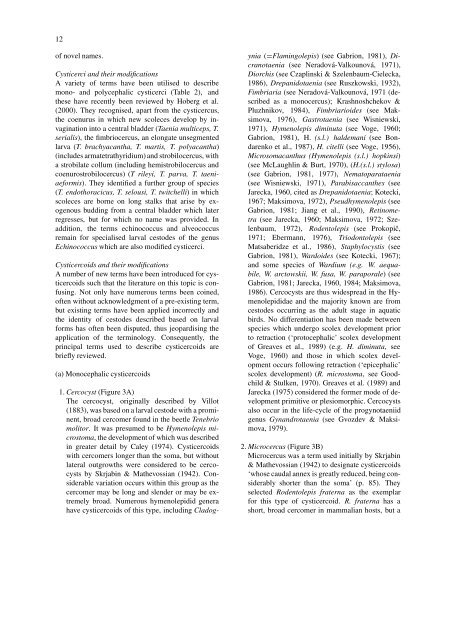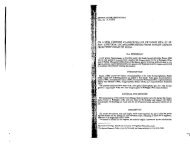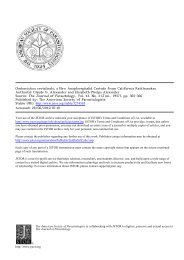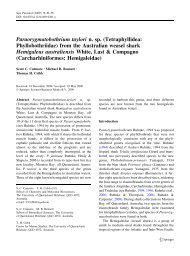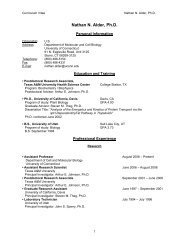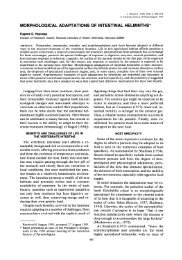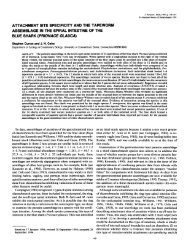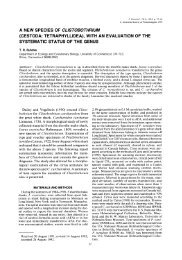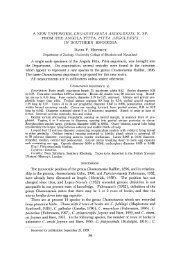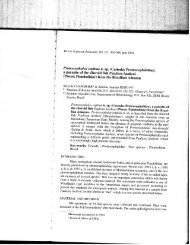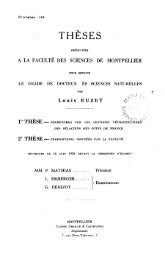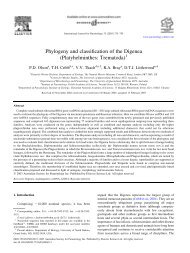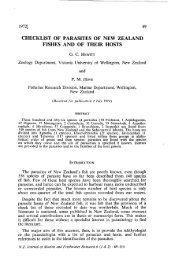The terminology of larval cestodes or metacestodes
The terminology of larval cestodes or metacestodes
The terminology of larval cestodes or metacestodes
Create successful ePaper yourself
Turn your PDF publications into a flip-book with our unique Google optimized e-Paper software.
12<strong>of</strong> novel names.Cysticerci and their modificationsA variety <strong>of</strong> terms have been utilised to describemono- and polycephalic cysticerci (Table 2), andthese have recently been reviewed by Hoberg et al.(2000). <strong>The</strong>y recognised, apart from the cysticercus,the coenurus in which new scoleces develop by invaginationinto a central bladder (Taenia multiceps, T.serialis), the fimbriocercus, an elongate unsegmentedlarva (T. brachyacantha, T. martis, T. polyacantha)(includes armatetrathyridium) and strobilocercus, witha strobilate collum (including hemistrobilocercus andcoenurostrobilocercus) (T rileyi, T. parva, T. taeniaef<strong>or</strong>mis).<strong>The</strong>y identified a further group <strong>of</strong> species(T. endoth<strong>or</strong>acicus, T. selousi, T. twitchelli) in whichscoleces are b<strong>or</strong>ne on long stalks that arise by exogenousbudding from a central bladder which laterregresses, but f<strong>or</strong> which no name was provided. Inaddition, the terms echinococcus and alveococcusremain f<strong>or</strong> specialised <strong>larval</strong> <strong>cestodes</strong> <strong>of</strong> the genusEchinococcus which are also modified cysticerci.Cysticercoids and their modificationsA number <strong>of</strong> new terms have been introduced f<strong>or</strong> cysticercoidssuch that the literature on this topic is confusing.Not only have numerous terms been coined,<strong>of</strong>ten without acknowledgment <strong>of</strong> a pre-existing term,but existing terms have been applied inc<strong>or</strong>rectly andthe identity <strong>of</strong> <strong>cestodes</strong> described based on <strong>larval</strong>f<strong>or</strong>ms has <strong>of</strong>ten been disputed, thus jeopardising theapplication <strong>of</strong> the <strong>terminology</strong>. Consequently, theprincipal terms used to describe cysticercoids arebriefly reviewed.(a) Monocephalic cysticercoids1. Cercocyst (Figure 3A)<strong>The</strong> cercocyst, <strong>or</strong>iginally described by Villot(1883), was based on a <strong>larval</strong> cestode with a prominent,broad cercomer found in the beetle Tenebriomolit<strong>or</strong>. It was presumed to be Hymenolepis microstoma,the development <strong>of</strong> which was describedin greater detail by Caley (1974). Cysticercoidswith cercomers longer than the soma, but withoutlateral outgrowths were considered to be cercocystsby Skrjabin & Mathevossian (1942). Considerablevariation occurs within this group as thecercomer may be long and slender <strong>or</strong> may be extremelybroad. Numerous hymenolepidid generahave cysticercoids <strong>of</strong> this type, including Cladogynia(=Flamingolepis) (see Gabrion, 1981), Dicranotaenia(see Neradová-Valkounová, 1971),Di<strong>or</strong>chis (see Czaplinski & Szelenbaum-Cielecka,1986), Drepanidotaenia (see Ruszkowski, 1932),Fimbriaria (see Neradová-Valkounová, 1971 (describedas a monocercus); Krashnoshchekov &Pluzhnikov, 1984), Fimbriarioides (see Maksimova,1976), Gastrotaenia (see Wisniewski,1971), Hymenolepis diminuta (see Voge, 1960;Gabrion, 1981), H. (s.l.) haldemani (see Bondarenkoet al., 1987), H. citelli (see Voge, 1956),Microsomacanthus (Hymenolepis (s.l.) hopkinsi)(see McLaughlin & Burt, 1970), (H.(s.l.) stylosa)(see Gabrion, 1981, 1977), Nematoparataenia(see Wisniewski, 1971), Parabisaccanthes (seeJarecka, 1960, cited as Drepanidotaenia; Kotecki,1967; Maksimova, 1972), Pseudhymenolepis (seeGabrion, 1981; Jiang et al., 1990), Retinometra(see Jarecka, 1960; Maksimova, 1972; Szelenbaum,1972), Rodentolepis (see Prokopič,1971; Ebermann, 1976), Triodontolepis (seeMatsaberidze et al., 1986), Staphylocystis (seeGabrion, 1981), Wardoides (see Kotecki, 1967);and some species <strong>of</strong> Wardium (e.g. W. aequabile,W. arctowskii, W. fusa, W. parap<strong>or</strong>ale) (seeGabrion, 1981; Jarecka, 1960, 1984; Maksimova,1986). Cercocysts are thus widespread in the Hymenolepididaeand the maj<strong>or</strong>ity known are from<strong>cestodes</strong> occurring as the adult stage in aquaticbirds. No differentiation has been made betweenspecies which undergo scolex development pri<strong>or</strong>to retraction (‘protocephalic’ scolex development<strong>of</strong> Greaves et al., 1989) (e.g. H. diminuta, seeVoge, 1960) and those in which scolex developmentoccurs following retraction (‘epicephalic’scolex development) (R. microstoma, see Goodchild& Stulken, 1970). Greaves et al. (1989) andJarecka (1975) considered the f<strong>or</strong>mer mode <strong>of</strong> developmentprimitive <strong>or</strong> plesiom<strong>or</strong>phic. Cercocystsalso occur in the life-cycle <strong>of</strong> the progynotaeniidgenus Gynandrotaenia (see Gvozdev & Maksimova,1979).2. Microcercus (Figure 3B)Microcercus was a term used initially by Skrjabin& Mathevossian (1942) to designate cysticercoids‘whose caudal annex is greatly reduced, being considerablysh<strong>or</strong>ter than the soma’ (p. 85). <strong>The</strong>yselected Rodentolepis fraterna as the exemplarf<strong>or</strong> this type <strong>of</strong> cysticercoid. R. fraterna has ash<strong>or</strong>t, broad cercomer in mammalian hosts, but a


